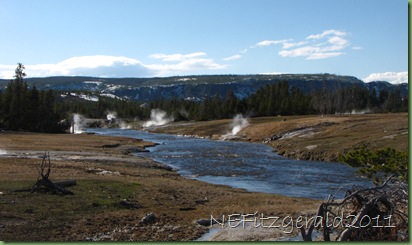It’s been three weeks since I arrived at Yellowstone and I’ve been to the Upper Geyser Basin an average of once a week. There is definitely some kind of attraction going on between me and these geothermal features.
 |
| Firehole River, Upper Geyser Basin, Yellowstone NP |
Old Faithful, in the Upper Geyser Basin along the Firehole River, seems to be the most famous geothermal feature in the park. It erupts more frequently than any of the other big geysers but it is not by any means the largest spouter, reaching an average height of a mere 140 feet. The tallest active geyser honor belongs to Steamboat Geyser in the Norris Geyser Basin. Totally unpredictable, Steamboat can experience days, months, or even years between major eruptions, but when it blows it can reach heights of more than 300 feet. The last known eruption of Steamboat occurred in 2005. I’m hoping it will erupt the next time I’m standing next to it.
The first time I walked along the boardwalks of the Upper Geyser Basin and watched Old Faithful erupt was two days after I arrived in Yellowstone. I saw so many geysers, hot springs, pools, mudpots, and fumaroles that I could not help but be astounded and nearly speechless. These things are literally everywhere!


A second time I was fortunate to watch Old Faithful erupt during training, and then last week I went back again with a co-worker (it’s only 19 miles from Grant Village) to amble along the trails and boardwalks out to Morning Glory Pool.


 |
| Morning Glory Pool |
 |
| Grotto Geyser |
So what exactly is a geyser, anyway?
Geysers are rare birds. They require a unique set of geological conditions in order for them to even exist at all. Taken alone, these conditions are nothing special, but the combination of them is what makes geysers so extraordinary. Geysers require a water supply, a plumbing system, a volcanic heat source, geyserite, and earthquakes. This post covers the water situation with a bit of plumbing thrown in.
According to the definition developed by the US Geological Survey, a geyser is a hot spring characterized by intermittent discharge of water ejected turbulently and accomplished by a vapor phase.
Geysers are hot springs. Some springs do erupt cold water, but these are not by-the-book geysers. Hot involves any water above 98.6°F, the average human body temperature.
Geysers erupt periodically or intermittently, not continuously. They spend some amount of time recovering from one eruption and preparing for the next.
Geyser eruptions are turbulent, not calm. There is no required minimum height for this turbulence. If the water surface is broken by the activity it is considered turbulent. A few inches of height qualifies.

Lastly, constrictions in the geyser’s underground “plumbing system” prevent water from freely circulating to the surface where heat could escape. Water that has fallen as rain or snow and slowly percolated downward over the centuries to more than a mile deep can reach temperatures upwards of 400°F – 500°F or even higher. Pressure surrounding this water also increases with depth. The increased pressure exerted by the massive weight of surrounding rock and overlying water prevents the deeper water from vaporizing – there just isn’t enough room for the hot water to expand, even though it is really, really hot!
Eventually, small steam bubbles do somehow form to rise and expand until they are too big and plentiful to pass through any tight spots in the constricted plumbing system. Here the water reaches a critical point when the confined bubbles are able to “lift” the overlying water above it. And so the geyser can now erupt.
Violent boiling results as pressure from the overlying water is decreased. Instantly, a spectacular volume of steam is produced, and it is this steam that has forced the overlying water out of the geyser vent in a superheated mass. The eruption ceases when the reservoir of water is exhausted or when the gas bubbles diminish enough to be able to rise without pushing up the overlying water.
There are geyser basins all over the park, and the one where I will spend many of my working hours this summer is West Thumb on Yellowstone Lake.
 |
| West Thumb Geyser Basin |
The main references used here are:
Bryan, T.S., 1990, Geysers: What They Are and How They Work, Roberts Rinehart Publishers.
Old Faithful Area Trail Guide and Norris Geyser Basin Trail Guide, National Park Service pamphlets available at all visitor centers!






